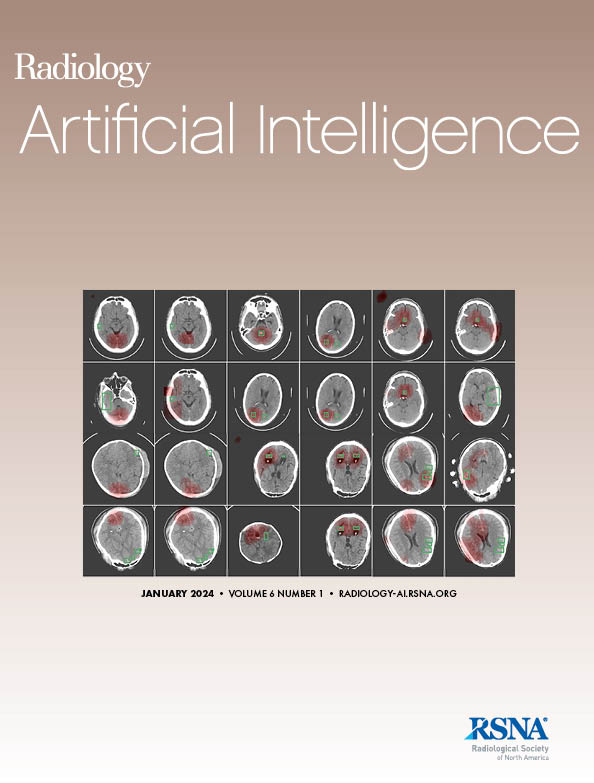Zhongyi Zhang, Julie A Hides, Enrico De Martino, Janet R Millner, Gervase Tuxworth
求助PDF
{"title":"Multicenter Validation of Automated Segmentation and Composition Analysis of Lumbar Paraspinal Muscles Using Multisequence MRI.","authors":"Zhongyi Zhang, Julie A Hides, Enrico De Martino, Janet R Millner, Gervase Tuxworth","doi":"10.1148/ryai.240833","DOIUrl":null,"url":null,"abstract":"<p><p>Chronic low back pain is a global health issue with considerable socioeconomic burdens and is associated with changes in lumbar paraspinal muscles (LPMs). In this retrospective study, a deep learning method was trained and externally validated for automated LPM segmentation, muscle volume quantification, and fatty infiltration assessment across multisequence MR images. A total of 1302 MR images from 641 participants across five centers were included. Data from two centers were used for model training and tuning, while data from the remaining three centers were used for external testing. Model segmentation performance was evaluated against manual segmentation using the Dice similarity coefficient (DSC), and measurement accuracy was assessed using two one-sided tests and intraclass correlation coefficients (ICCs). The model achieved global DSC values of 0.98 on the internal test set and 0.93 to 0.97 on external test sets. Statistical equivalence between automated and manual measurements of muscle volume and fat ratio was confirmed in most regions (<i>P</i> < .05). Agreement between automated and manual measurements was high (ICCs > 0.92). In conclusion, the proposed automated method accurately segmented LPM and demonstrated statistical equivalence to manual measurements of muscle volume and fatty infiltration ratio across multisequence, multicenter MR images. <b>Keywords:</b> MR-Imaging, Muscular, Volume Analysis, Segmentation, Vision, Application Domain, Quantification, Supervised Learning Type of Machine Learning, Convolutional Neural Network (CNN), Deep Learning Algorithms, Machine Learning Algorithms <i>Supplemental material is available for this article.</i> © RSNA, 2025.</p>","PeriodicalId":29787,"journal":{"name":"Radiology-Artificial Intelligence","volume":" ","pages":"e240833"},"PeriodicalIF":13.2000,"publicationDate":"2025-09-01","publicationTypes":"Journal Article","fieldsOfStudy":null,"isOpenAccess":false,"openAccessPdf":"","citationCount":"0","resultStr":null,"platform":"Semanticscholar","paperid":null,"PeriodicalName":"Radiology-Artificial Intelligence","FirstCategoryId":"1085","ListUrlMain":"https://doi.org/10.1148/ryai.240833","RegionNum":0,"RegionCategory":null,"ArticlePicture":[],"TitleCN":null,"AbstractTextCN":null,"PMCID":null,"EPubDate":"","PubModel":"","JCR":"Q1","JCRName":"COMPUTER SCIENCE, ARTIFICIAL INTELLIGENCE","Score":null,"Total":0}
引用次数: 0
引用
批量引用
Abstract
Chronic low back pain is a global health issue with considerable socioeconomic burdens and is associated with changes in lumbar paraspinal muscles (LPMs). In this retrospective study, a deep learning method was trained and externally validated for automated LPM segmentation, muscle volume quantification, and fatty infiltration assessment across multisequence MR images. A total of 1302 MR images from 641 participants across five centers were included. Data from two centers were used for model training and tuning, while data from the remaining three centers were used for external testing. Model segmentation performance was evaluated against manual segmentation using the Dice similarity coefficient (DSC), and measurement accuracy was assessed using two one-sided tests and intraclass correlation coefficients (ICCs). The model achieved global DSC values of 0.98 on the internal test set and 0.93 to 0.97 on external test sets. Statistical equivalence between automated and manual measurements of muscle volume and fat ratio was confirmed in most regions (P < .05). Agreement between automated and manual measurements was high (ICCs > 0.92). In conclusion, the proposed automated method accurately segmented LPM and demonstrated statistical equivalence to manual measurements of muscle volume and fatty infiltration ratio across multisequence, multicenter MR images. Keywords: MR-Imaging, Muscular, Volume Analysis, Segmentation, Vision, Application Domain, Quantification, Supervised Learning Type of Machine Learning, Convolutional Neural Network (CNN), Deep Learning Algorithms, Machine Learning Algorithms Supplemental material is available for this article. © RSNA, 2025.
多序列MRI对腰椎棘旁肌肉自动分割和组成分析的多中心验证。
“刚刚接受”的论文经过了全面的同行评审,并已被接受发表在《放射学:人工智能》杂志上。这篇文章将经过编辑,布局和校样审查,然后在其最终版本出版。请注意,在最终编辑文章的制作过程中,可能会发现可能影响内容的错误。慢性腰痛是一个全球性的健康问题,具有相当大的社会经济负担,并与腰椎棘旁肌(LPM)的变化有关。在这项回顾性研究中,对一种深度学习方法进行了训练并进行了外部验证,用于跨多序列mri的自动LPM分割、肌肉体积量化和脂肪浸润评估。来自五个中心641名参与者的1302份核磁共振成像被纳入研究。来自两个中心的数据用于模型训练和调优,而来自其余三个中心的数据用于外部测试。使用Dice相似系数(DSC)评估模型分割性能,使用两个单侧检验和类内相关系数(ICCs)评估测量精度。模型在内部测试集上实现了0.98的全局DSC值,在外部测试集上实现了0.93 ~ 0.97的全局DSC值。在大多数地区,自动和人工测量肌肉体积和脂肪比的统计等效性得到证实(P < 0.05)。自动测量和人工测量的一致性很高(ICCs > 0.92)。综上所述,所提出的自动化方法准确地分割了LPM,并且在多序列、多中心mri上显示了与手动测量肌肉体积和脂肪浸润比的统计等效。©RSNA, 2025年。
本文章由计算机程序翻译,如有差异,请以英文原文为准。

 求助内容:
求助内容: 应助结果提醒方式:
应助结果提醒方式:


